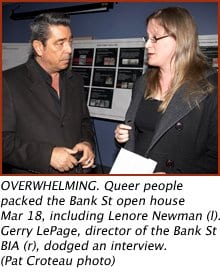With politicians from all three levels of government onside, dreams of getting rainbows on Bank St are one step closer to becoming a reality.
This follows a Mar 18 open house where 150 participants overwhelmingly called for rainbow signage on Bank, roughly between Nepean and James.
Diane Holmes is the Somerset ward councillor.
“I certainly heard loud and clear from the GLBT community that there were upset that there isn’t any physical representation on the street,” she says.
After two years of calling for rainbows for the street, those at the meeting were respectful but firm that plans for a redesigned street should include some acknowledgement of the high density of gays and lesbians in the area. For the last six months, gay business owner Glenn Crawford and Pink Triangle Service’s Ricky Barnes have said as much at planning meetings. Dozens of queer people filled out comment cards at the meeting.
Holmes’ federal and provincial counterparts have also pledged their support.
NDP MP Paul Dewar represents the area federally. He says that using a rainbow to brand the area reinforces what “most people already know.
“I’m in favour,” he says. “It’s a logical thing to do.”
Dewar is careful to say that rainbow flags will not make Bank St a gay neighbourhood. “It’s not a superimposition,” he says. Rather, the developments are a recognition that it’s already where queer people live and play.
“Often when there’s redevelopment going on, it provides an opportunity to take what’s already organically understood, and give it a physical manifestation,” says Dewar.
His office is drafting its official letter of support.
Liberal Yasir Naqvi represents the neighbourhood provincially. He says he’s in favour of using rainbows to denote the neighbourhood’s character.
“I personally think that’s a good idea,” he says. “We obviously need to celebrate diversity on Bank Street.”
He says he’s asked local businesses for their input. He’s noted some reservations from people who are afraid of going too far too fast but he hopes that the area can tap the gay community’s “zest for life.”
“What I would like to see is that it’s inclusive — and this is from talking to the businesses on Bank St — that it’s GLBTTQ friendly, not GLBTTQ exclusive,” he says.
“There’s a great harmony that exists; we want to foster that,” he says.
The renovation of Bank St coincides with efforts to update the 100-year-old pipes that run under the street. That construction will close Bank St from Laurier to Somerset for most of the summer.
Area businesses are the last piece in the puzzle. So far, reception from the Bank St Business Improvement Area (BIA) has been cool. After Capital Xtra staff requested an interview with executive director Gerry LePage at the open house, LePage left, promising to return about an hour later. He never did and subsequent requests for an interview have gone unanswered.
Holmes has a meeting with LePage shortly after Capital Xtra goes to press. She’s confident that he and other businesses will see the advantages of rainbow flags or street signs.
“With anything new, there’s apprehension,” she says. “I find, if things are explained to people, then they come around.”
She points out that it was the city, not the local BIAs, that paid for the distinctive street signs on Preston Street’s Corso Italia and Somerset’s Chinatown — but both were done at the request of the BIA.
According to Holmes, local gays still have time to sell businesses on the idea of rainbow identifiers for the neighbourhood. For now, the queer community should “in a positive way, let businesses know that they appreciate that Bank St is gay-friendly.”
“I don’t want to get anyone’s back up yet,” she says.
But with area residents strongly advocating for the rainbows, it’s clear that their client base is eager for them to agree, says Glenn Crawford. He runs his own design firm near Bank and James St and has been sitting on the city’s Public Advisory Committee.
“It’s a good idea to get the message out that we do expect a little bit more, but at the same time, we’re not looking to burn bridges,” says Crawford.
Like Holmes, Crawford has a number of meetings in the works to help convince whatever skeptics are left. He says he’ll be using community’s attendance at the open house to leverage support from any stragglers.
“We’ve sent a clear message that we’re the people who are passionate about the area. We can’t be invisible in our community,” he says.
He sees two key opportunities resulting from the design plans unveiled at the open house. The first is getting a rainbow on the street signs. That’s an inexpensive and durable way to get the Village recognized — especially since the city will be replacing the signs after reconstruction is finished anyway.
“The street signs in particular are a symbol of our acceptance by the city,” he says. “I think that’s why that’s important.”
The second is rainbow banners. After advocating for street lights that have room for two banners, Crawford was upset to see that the design at the open house only had one. With only one banner, it’s unlikely that the posts will be flying anything other than Bank St BIA banners.
“The banners are something that fit with the reconstruction front. They’re tasteful and they add colour. It’s nice to have something that isn’t an advertising kiosk,” says Crawford.
He estimates the total cost of the banners would be less than $10,000.
“What it says is that it’s not that much money. Surely the city and the BIA can find that kind of money somewhere,” he says.
The informal survey Crawford conducted last year listed street signs and banners as the gay community’s top priorities for the neighbourhood.
Like Holmes, Crawford recommends that those who want to stay involved should encourage the Bank St businesses to support the project. Talk to your merchants and tell them you’re gay and you want rainbow banners. Let them know you spend money in their shop.
“If people want to get involved, that’s certainly one place they can help — being out and visible,” he says. “It’s also about letting them know what percent of their clientele is gay.
Even though Crawford was surprised to see that official plans don’t yet sport recognition for our community, he’s still enthusiastic.
“From the beginning I’ve thought that was an achievable goal. We’ve made strong contacts, been consistently there through the process, and professional and consistent in our message,” he says.


 Why you can trust Xtra
Why you can trust Xtra


